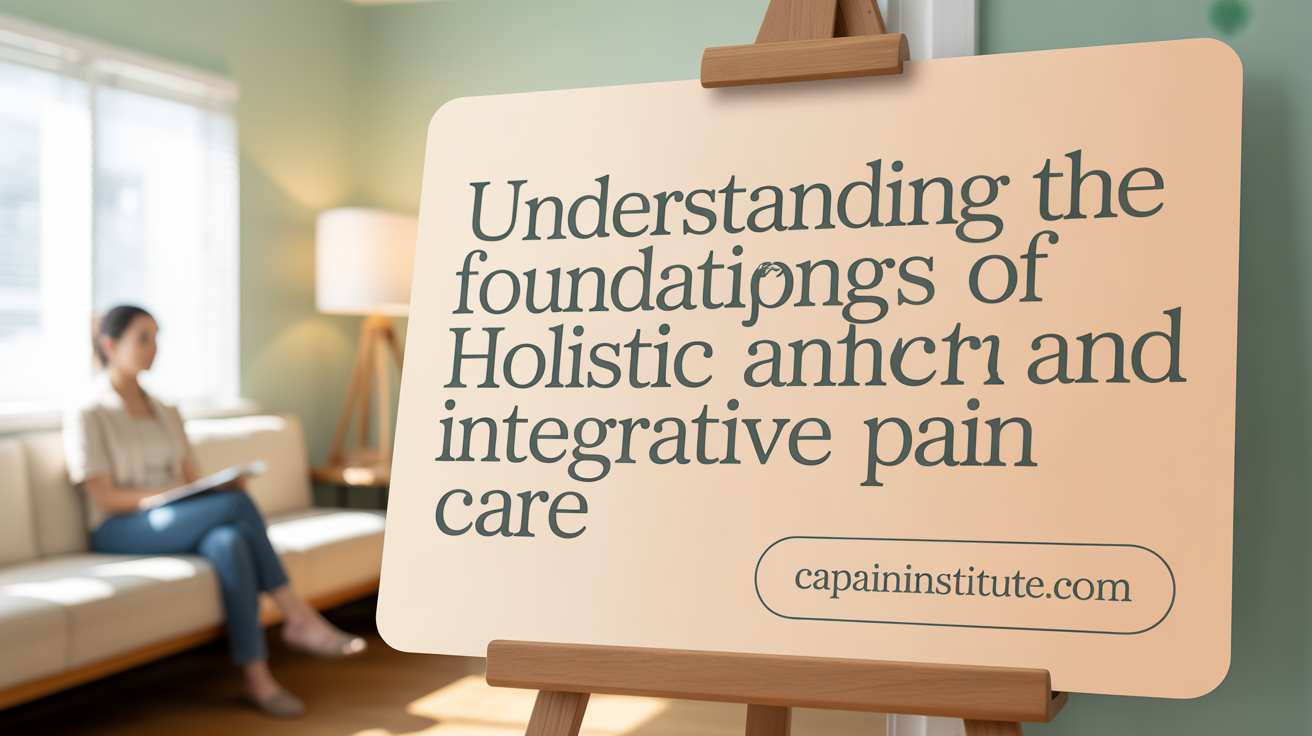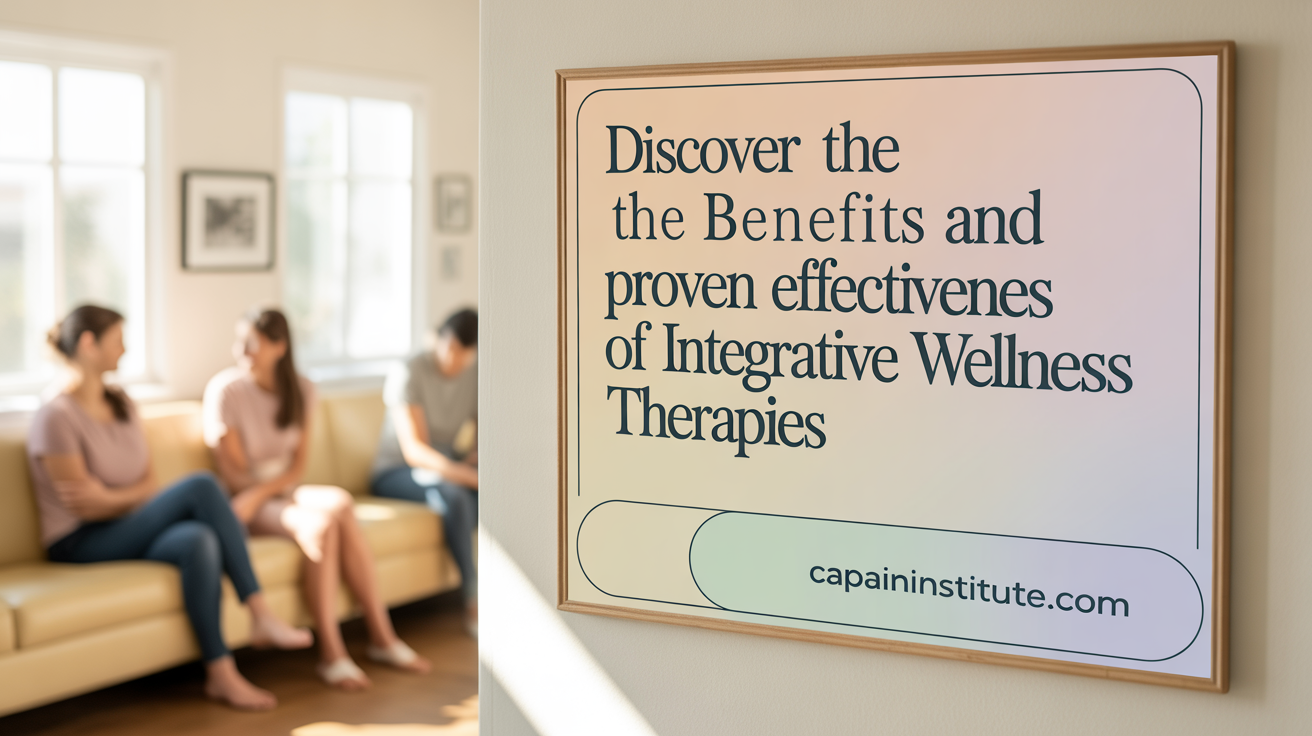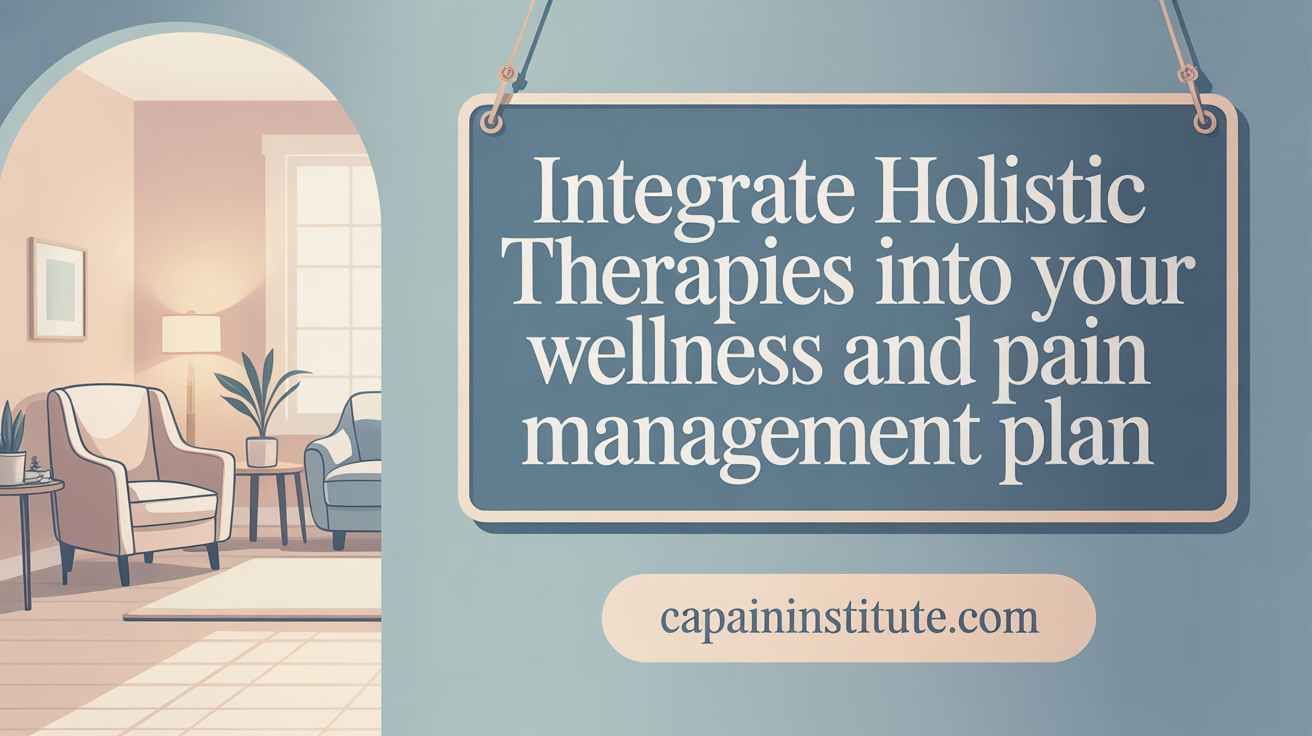Understanding Integrative and Holistic Pain Management
Chronic pain affects millions worldwide and demands approaches beyond conventional medication to provide lasting relief and improve quality of life. Integrative and holistic pain management offers a multidimensional strategy that addresses not only the physical symptoms but also the emotional, mental, and lifestyle factors contributing to pain. This article explores the principles, therapies, benefits, and implementation of these approaches to guide those seeking well-rounded pain relief solutions.
Foundations of Holistic and Integrative Pain Management

Why is a holistic approach important in managing pain and discomfort?
A holistic approach to pain management considers the whole person, not just the symptoms. It recognizes that pain is influenced by physical, emotional, mental, and environmental factors. By addressing these multiple dimensions, patients often experience more effective and sustained relief.
For example, treatments like chiropractic adjustments and massage therapy can help reduce musculoskeletal tension and correct structural imbalances. When combined with proper nutrition—such as anti-inflammatory diets rich in vitamins and minerals—the body's natural healing capability is enhanced. This synergistic strategy improves nerve function, boosts mobility, and promotes emotional well-being.
Ultimately, a holistic approach provides a comprehensive pathway to manage pain that goes beyond quick fixes. It aims to improve overall quality of life by fostering physical health, mental resilience, and emotional balance, which are vital in long-term pain relief.
What is the integrative approach to pain management?
The integrative approach to pain management is a comprehensive, patient-centered model that combines evidence-based physical therapies, behavioral strategies, and lifestyle modifications. It uses a variety of modalities such as massage therapy, osteopathic manipulation, acupuncture, and mind-body practices like mindfulness, Tai Chi, and yoga.
This approach emphasizes educating patients about pain neuroscience, promoting self-management skills, and improving sleep and nutrition habits. By focusing on the person as a whole, it reduces the reliance on medications or invasive procedures and prioritizes natural, minimally invasive therapies.
Programs at institutions like UC San Diego’s Center for Integrative Medicine exemplify this method by incorporating trauma-informed care, fostering collaboration among multidisciplined providers, and tailoring treatments to individual needs. The goal is to enhance overall wellness, improve function, and empower patients in their pain management journey.
| Aspect | Focus | Benefits |
|---|---|---|
| Treatments | Massage, acupuncture, osteopathic care, mind-body therapies | Reduce pain, improve mobility, decrease stress |
| Lifestyle | Nutrition, sleep, stress management | Enhance healing, prevent flare-ups |
| Education & Support | Patient empowerment, group visits | Encourage self-management, confidence |
| Approach | Personalized, multidisciplinary, minimally invasive | Effective relief, improved quality of life |
This integrative method exemplifies a shift from solely symptom-focused care to addressing the whole person, promoting sustainable health and comfort.
Key Holistic Therapies for Chronic Pain Relief

What are some effective holistic approaches for managing chronic muscle pain?
Managing chronic muscle pain often requires a comprehensive approach that addresses both physical and mental factors. Acupuncture, a technique involving the insertion of fine needles at specific points on the body, has been shown to stimulate energy flow and promote healing. It helps reduce inflammation and muscle tension, providing relief for muscle-related discomfort.
Massage therapy is another valuable modality that manipulates soft tissues to relax tense muscles, improve circulation, and decrease pain. Chiropractic care, which involves spinal adjustments, can also alleviate nerve pressure and correct structural misalignments that contribute to muscle pain.
Herbal remedies such as turmeric, ginger, and white willow bark are known for their anti-inflammatory properties, supporting joint and muscle health effectively.
Practicing yoga and Tai Chi strengthens core muscles, enhances flexibility, and promotes mental relaxation, all of which can alleviate muscle soreness and stiffness.
Additionally, mind-body techniques like meditation, biofeedback, and traditional Chinese medicine modalities such as cupping therapy and Tui Na massage foster holistic pain relief.
Which therapies are considered alternative treatments for chronic pain?
Several therapies are categorized as alternative treatments that complement conventional medicine for managing chronic pain. Acupuncture remains one of the most studied and validated options, effective for conditions such as back pain, migraines, and osteoarthritis.
Massage therapy and chiropractic care offer hands-on techniques to relax muscles, improve movement, and alleviate nerve pressure.
Yoga and tai chi are gentle movement practices that improve strength, flexibility, and balance while supporting mental health.
Mindfulness-based approaches, including meditation and relaxation techniques, help reduce stress hormones and distract from pain sensations.
Physical therapy aims to restore function, improve mobility, and reduce discomfort through targeted exercises, stretching, and nerve stimulation.
All these therapies are supported by research indicating they can significantly improve quality of life, especially when integrated into a comprehensive pain management plan that may also include medications or other medical interventions.
Benefits and Effectiveness of Integrative Treatments
 Many alternative therapies for chronic pain have strong scientific backing, demonstrating their ability to alleviate symptoms and improve quality of life. Acupuncture, for example, has been supported by systematic reviews and randomized controlled trials as an effective treatment for conditions such as back pain, migraines, osteoarthritis, and shoulder pain. This approach involves inserting fine needles at specific points to stimulate the nervous system, yielding decreased pain levels and improved function.
Many alternative therapies for chronic pain have strong scientific backing, demonstrating their ability to alleviate symptoms and improve quality of life. Acupuncture, for example, has been supported by systematic reviews and randomized controlled trials as an effective treatment for conditions such as back pain, migraines, osteoarthritis, and shoulder pain. This approach involves inserting fine needles at specific points to stimulate the nervous system, yielding decreased pain levels and improved function.
Massage therapy manipulates soft tissues to help relax muscles, increase blood flow, and reduce stress. Studies have shown it provides significant short-term relief for neck pain, lower back pain, and post-operative discomfort, with improvements in sleep, anxiety, and overall well-being.
Yoga and tai chi combine gentle movement, breathing exercises, and meditation. Research indicates that yoga not only reduces pain severity in conditions like chronic lower back and neck pain but also enhances physical functionality and emotional health. Tai chi has been shown to lessen pain and improve mobility, especially in people with osteoarthritis and low-back pain.
Mindfulness practices, including meditation and guided imagery, have been associated with decreased pain perception and reduced psychological distress. These mind-body therapies help manage pain by altering the way individuals perceive and respond to discomfort, leading to long-term benefits such as decreased pain intensity and improved mood.
Compared to conventional treatments like medication or surgery, these alternative approaches often have fewer adverse effects and can serve as adjuncts to traditional medicine. They are especially appealing for patients seeking non-pharmacologic options or looking to minimize medication use.
Overall, the evidence suggests that these therapies can bring meaningful improvements in physical function, reduce pain levels, and boost overall quality of life for many with chronic pain conditions. When administered by qualified practitioners, integrative treatments can be safe, effective, and an important part of a comprehensive pain management plan.
Safety and Suitability of Holistic Pain Therapies
 When exploring holistic therapies for managing chronic pain, safety considerations are paramount to ensure effective and harm-free treatment.
When exploring holistic therapies for managing chronic pain, safety considerations are paramount to ensure effective and harm-free treatment.
First, it is important to verify that practitioners are properly qualified and certified. Licensed health professionals who specialize in modalities like acupuncture, chiropractic care, massage therapy, or herbal medicine follow safety protocols designed to protect patients. These practitioners should have proper training, credentials, and experience relevant to their specific therapy.
Patients should also communicate openly with their healthcare providers about all current health conditions, medications, and treatments. Full disclosure helps prevent potential adverse interactions, especially with herbal supplements and other non-prescription remedies, which might contain contaminants or substances that interact negatively with existing medications.
Risks and contraindications vary across therapies. For example, movement practices such as yoga or tai chi may pose risks of injury if performed improperly or if the individual has certain musculoskeletal issues. Herbal medicines, while natural, can cause side effects or adverse interactions if not used appropriately. For instance, some herbs like white willow bark act as blood thinners and could increase bleeding risk.
It is crucial to avoid unregulated or unproven treatments that lack scientific backing or proper safety oversight. Patients should seek therapies supported by credible research and provided by qualified practitioners. Consulting with healthcare providers before initiating new treatments helps determine if they are appropriate for the individual's specific health status.
In summary, ensuring practitioner qualifications, full disclosure of health information, adherence to safety protocols, and reliance on evidence-based therapies significantly contribute to the safe use of holistic approaches for pain management. Being cautious of unregulated treatments safeguards overall health and prevents unnecessary risks.
Integrating Holistic Methods Into Pain Management Plans and Programs
 Patients looking to enhance their pain management routines can benefit from integrating holistic therapies alongside conventional treatments. This requires close collaboration with healthcare providers to create personalized, multidisciplinary plans that include therapies such as acupuncture, massage, mindfulness meditation, yoga, tai chi, and nutritional counseling. Programs like Integrated and Comprehensive Pain Management Programs (IPMPs or CPMPs) coordinate various modalities to address not just the physical symptoms, but also the emotional and psychological factors associated with chronic pain.
Patients looking to enhance their pain management routines can benefit from integrating holistic therapies alongside conventional treatments. This requires close collaboration with healthcare providers to create personalized, multidisciplinary plans that include therapies such as acupuncture, massage, mindfulness meditation, yoga, tai chi, and nutritional counseling. Programs like Integrated and Comprehensive Pain Management Programs (IPMPs or CPMPs) coordinate various modalities to address not just the physical symptoms, but also the emotional and psychological factors associated with chronic pain.
A structured holistic pain program often involves an initial evaluation by an integrative medicine physician. This assessment helps in developing a tailored treatment plan that incorporates lifestyle changes, mental health support, and possibly emerging therapies like regenerative medicine. Patients may participate in group education sessions and receive support that empowers them to actively participate in their own care, promoting long-term relief and a better quality of life.
Complementary therapies such as acupuncture, yoga, and massage are shown to reduce pain intensity and improve mobility. Additionally, mind-body practices like meditation and tai chi help lower stress levels, contributing to pain reduction. These therapies often work best in combination, amplifying their benefits and sometimes reducing the need for medications such as opioids.
By embracing a holistic approach, patients can address the complex nature of chronic pain, which often involves physical, emotional, and social dimensions. This integrated method fosters open communication and collaboration among various health professionals, ensuring comprehensive and patient-centered care. Ultimately, such programs aim to manage pain more effectively, improve overall well-being, and help patients regain control over their lives.
Advancing Pain Management Through Holistic Integration
Integrative and holistic approaches to pain management represent a forward-thinking paradigm that acknowledges the complexity of chronic pain. By combining scientifically supported complementary therapies with conventional medical practices, patients receive personalized care targeting the physical, emotional, and lifestyle dimensions of their pain. This comprehensive focus not only provides meaningful pain relief but also enhances overall health, functionality, and quality of life. Ensuring safety through professional guidance and patient education further strengthens outcomes. As awareness and research expand, the integration of these modalities will likely become an essential component of effective chronic pain treatment, offering hope and empowerment for those seeking lasting comfort and improved well-being.
References
- Holistic Pain Management Program | Cleveland Clinic
- The Benefits of Integrative Medicine in the Management of Chronic ...
- Holistic Pain Management - Hennepin Healthcare
- 5 alternative treatments for chronic pain | UCLA Health
- Chronic Pain and Complementary Health Approaches
- Integrative Approaches To Pain Management | Momentum Medical
- Integrative Pain Management Program | Mount Sinai - New York
- Combatting Chronic Pain: Holistic Approaches for Long-Term Relief
- Integrative Medicine in Pain Management: A Holistic Approach
